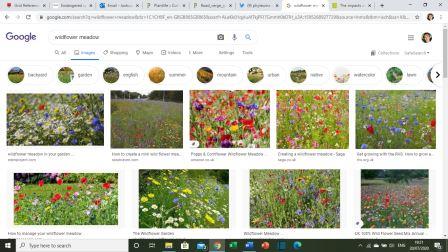The Increase in Road Verge Wilding and the Role of Native Flora
This post is greater than 6 months old - links may be broken or out of date. Proceed with caution!

By Joshua Styles, NWRPI Project Co-ordinator and Ecologist
Plants are the fundamental basis of most life on Earth. Aside from their undeniable ecological importance, they themselves are fascinating organisms, which are more than worthy of preservation. They can be devious, like the Broomrapes in the genus Orobanche, stealing nutriment from host plants, predatory, like our wonderful, insectivorous Great Sundew (Drosera anglica), and they can cooperate with other organisms, like Common Cow-wheat (Melampyrum pratense), in its production of sugary elaiosomes, attracting wood ants (Formica spp.) to disperse its fruits. Plants are extraordinarily exciting creatures that are just as alive and vivacious as any vertebrate!
Introduction

Of the 1500 wonderful, native vascular plant species resident across the British Isles, around 700 of these have been recorded across our road verges, equating to 45% of our native flora. This includes some exceptionally rare and threatened species, such as the nationally rare Spiked Rampion (Phyteuma spicatum) (Figure 1), an Endangered species in England, whose largest extant population is sited on a road verge in Sussex. Indeed, of the 700 species recorded across road verges, figures by Plantlife indicate that 87 of these are threatened with extinction in the UK, which includes more widespread species (Plantlife, 2019).
Aside from the sheer quantity of plant species recorded across them, road verges are known to cover a stretch of 313,500 miles, totalling an area more than all of our semi-natural, unimproved meadows combined. They represent a significant biodiversity asset, however, poor management employed by local authorities, often going against their legal duty to biodiversity conservation (Natural England & DEFRA, 2014), has meant that our verges are often left in a poor state for wildlife, particularly for plants and invertebrates.
Although our verges may be poorly managed by and large, the tides are turning; local authorities across the UK are adopting a shift in management. Burnley, Denbighshire, Dorset, Hertfordshire, Nottinghamshire, and Sheffield councils to name a few, have all changed the way in which they manage their verges by relaxing cutting regimes, recognising the necessity for a shift from the norm. In addition to the improved wildlife value of relaxed mowing regimes, many councils have also reported significant savings; Dorset Council reports annual savings of £93k, whilst Burnley Council has previously reported annual savings of £63k.
Native vs Non-native

Many local authorities have adopted positive changes in management simply by mowing less, and mowing later, acting on sound ecological advice. However, other authorities, including Rotherham Council, have made less desirable changes, replacing grassy verges and central reservations with non-native displays, perversely repackaging these mixes as a form of ‘restoration’ (Figure 2).

Although the ecological drawbacks of such changes may not be immediately apparent, they are manifold. To maintain such colourful displays of annual plants year-on-year firstly requires regular herbicide treatment, eliminating all plants that were there in the first instance and displacing native flora. Further to the destructive initial and ongoing impacts that such displays demand, displays like these also have an ability to alter public perception of what a wildflower meadow is. A simple google search of ‘wildflower meadow’ demonstrates how perception has altered from grassy meadows filled with orchids and other native plants (Figure 3), to mixes of colourful non-native species including Cornflower (Centaurea cyanus), Corn Marigold (Glebionis segetum) and Common Poppy (Papaver rhoeas).
Further to the alteration of public perception and constant herbicide application, it should also be noted that between 0.0125 – 0.8% of all non-native plant species introduced to this country go to become notifiable invasive species (Manchester & Bullock, 2001). Invasive plants on the whole are estimated to cost the economy £1.7 billion annually (Shaw et al, 2014), as well as cause tremendous damage to ecosystems.
“But what about the ecological value of non-native displays?”
Non-native species mixes are often sown with pollinators in mind. However, this does not account for specialists, adapted to particular species of flowering plant, and typically favours generalists only. Furthermore, it does not consider the specific host plants required by many invertebrates. Table 1 compares the number of insect associates between a number of plants commonly found across grassy verges in Britain, compared to species commonly sown in non-native displays.

Concluding remarks
Whilst the desire to encourage biodiversity appears to be improving across local authorities and across the UK more widely, it is important that public open spaces are managed in light of the best science and guidance available, to ensure that both people and wildlife benefit from changes to management strategies. Although non-native species may produce visually appealing displays, they are of little benefit to the vast majority of our native invertebrates, which co-evolved with native plants; incorporation and enhancement of native plant diversity is paramount to dampening declines in plants and invertebrates.

For further information on good-practice verge and grassland management, see Plantlife’s Good Verge Guide here.
Find out more about Josh’s work at www.NWRPI.weebly.com
Refences
Biological Records Centre (BRC), 2020. Database of Insects and their Food Plants. Available from: http://www.brc.ac.uk/dbif/hosts.aspx
Manchester, S. J. & Bullock, J. M., 2001. ‘The impacts of non‐native species on UK biodiversity and the effectiveness of control.’ Journal of Ecology. Available from: https://besjournals.onlinelibrary.wiley.com/doi/full/10.1046/j.1365-2664.2000.00538.x
Natural England & Defra., 2014. Biodiversity duty: public authority duty to have regard to conserving biodiversity. Available from: https://www.gov.uk/guidance/biodiversity-duty-public-authority-duty-to-have-regard-to-conserving-biodiversity
Plantlife., 2019. The good verge guide. Available from: https://www.plantlife.org.uk/application/files/4614/8232/2916/Road_verge_guide_17_6.pdf
Shaw, R., Parr, M., Pollard, K., Williams, F., 2014. Demonstrating the cost of invasive species to Great Britain. Available from: https://www.cabi.org/wp-content/uploads/CABI-Study-Brief-1.pdf
More from North West Rare Plant Initiative